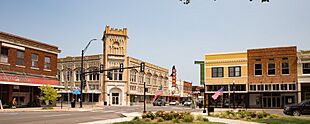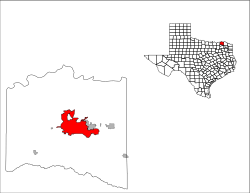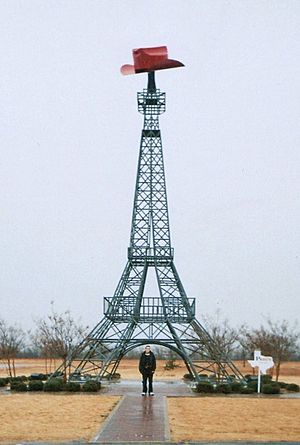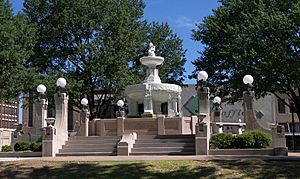Paris, Texas facts for kids
Quick facts for kids
Paris
|
|
|---|---|
|
City
|
|

Historic Downtown Paris
|
|
| Motto(s):
Where Texans Reach Higher
|
|

Location of Lamar County
|
|
| Country | United States |
| State | Texas |
| County | Lamar |
| Settled | by 1824 |
| Named | 1844 |
| Incorporated | 1845 |
| Named for | Paris, France |
| Area | |
| • Total | 37.07 sq mi (96.00 km2) |
| • Land | 35.19 sq mi (91.14 km2) |
| • Water | 1.88 sq mi (4.86 km2) |
| Elevation | 591 ft (180 m) |
| Population
(2020)
|
|
| • Total | 24,171 |
| • Density | 652.04/sq mi (251.781/km2) |
| Time zone | UTC−6 (Central (CST)) |
| • Summer (DST) | UTC−5 (CDT) |
| ZIP codes |
75460-75462
|
| Area code(s) | 903/430 |
| FIPS code | 48-55080 |
| GNIS feature ID | 2411371 |
| Website | paristexas.gov |
Paris is a city in Northeast Texas, located at the western edge of the Piney Woods. It is the main city and county seat for Lamar County, Texas. In 2020, about 24,171 people lived here.
History of Paris, Texas
The area around Paris, Texas, was first settled by pioneers in the early 1800s. People started arriving as early as 1824. By 1839, a man named George W. Wright bought 1,000 acres of land on a hill and opened a general store. This store was on an old road that connected the Red River to the Grand Prairie.
In December 1840, a new county was formed and named Lamar County after Mirabeau B. Lamar, who was the President of the Republic of Texas. By September 1841, Wright's store and the surrounding settlement became known as Paris, and it served as the local post office.
Becoming the County Seat
The original county seat was Lafayette, a small town a few miles northwest of where Paris is now. But in 1842, a law was passed saying that county seats had to be within five miles of the county's center.
In 1844, George Wright offered to donate 50 acres of land if Paris was chosen as the new county seat. The county leaders agreed, and Paris officially became the county seat. The first county court meeting in Paris happened on April 29, 1844.
Paris was officially made a city by the Congress of the Republic of Texas on February 3, 1845. It was also located on the Central National Road of the Republic of Texas, which was an important route.
Growth and Challenges
By the time of the American Civil War, Paris had about 700 residents. It became an important center for trading cattle and farm goods. It was also home to the first city-owned meat processing plant in the United States.
Paris faced several major fires throughout its history. Large fires happened in 1877, 1896, and 1916. The fire in 1916 was especially bad. It destroyed almost half of the town, including most of the main business area and many homes. The damage was estimated at $11 million. The fire started on March 21, 1916, and strong winds helped it spread quickly. Firefighters from Paris and nearby cities worked to control it by the next morning.
Eiffel Tower Replica
Many towns named "Paris" in the United States have built smaller versions of the famous Eiffel Tower from Paris, France.
Paris, Texas, built its own Eiffel Tower replica in 1993. It was 65 feet tall. In 1998, to make it unique and taller than other replicas, a large red cowboy hat was added to the top! This made Paris, Texas, claim to be "The second largest Paris in the World" (after Paris, France).
However, in 1999, Las Vegas built a much taller Eiffel Tower replica, which is 540 feet tall.
Historical Homes
Paris has several beautiful old homes from the late 1800s and early 1900s. One example is the Rufus Fenner Scott Mansion, built in 1910. It's made of solid concrete and steel and has four floors. Rufus Scott was a successful businessman. This mansion was one of the few buildings that survived the big fire of 1916.
Another historic home is the William Belford Wise house, which is a great example of the Queen Anne style architecture from the Victorian era.
Education and Learning
Paris offers several options for education, from elementary school to college.
School Districts
Students in Paris attend schools in different districts:
- Paris Independent School District
- North Lamar Independent School District
- Chisum Independent School District
Paris Junior College
Paris Junior College was started in 1924 and is one of the oldest junior colleges in Texas. It has many buildings and offers both technical training and academic classes.
The college is especially known for its jewelry technology department, called The Texas Institute of Jewelry Technology. This school is recognized worldwide for teaching students how to work with jewelry.
The Paris Junior College Dragon's Men's basketball team won a national championship in 2005. The college has three campuses in Texas: the main one in Paris, and others in Sulphur Springs and Greenville.
Libraries
The Paris Public Library serves the city, and the Lamar County Genealogical Society Library is also available for research.
Transportation in Paris
Paris has been an important center for railroads for a long time. The first railway, the Texas and Pacific, arrived in 1876. Other railways followed, connecting Paris to many places.
Highways
Four main highways serve Paris:
Paris is one of the largest cities in Texas that doesn't have a four-lane highway directly connected to an interstate highway within the state. However, you can travel north on US 271 into Oklahoma and connect to other major roads.
Public Transportation
Paris has a local bus service called the "Paris Metro," which runs hourly on weekdays. This service is part of the Ark-Tex Council of Governments Rural Transit District (TRAX).
Rail and Air Travel
Today, the rail lines in Paris are mostly used for moving goods (freight). There are no passenger train services like Amtrak.
For air travel, Cox Field is an airport that provides services for smaller planes.
Trails
Paris is also part of the Northeast Texas Trail (NETT). This is a long trail, about 130 miles, for hiking and biking. It follows old railroad tracks that are no longer in use.
Geography and Climate
Paris is located at 33°39′45″N 95°32′52″W / 33.66250°N 95.54778°W. The city covers about 44.4 square miles, with most of it being land and a small part being water.
Climate in Paris
Paris has a humid subtropical climate, which means it has hot, humid summers and mild winters. It is located in "Tornado Alley," an area in the central United States where tornadoes happen often due to specific weather patterns.
- Summer: Average high temperatures reach about 94-95 degrees Fahrenheit in July and August.
- Winter: Average high temperatures are around 51 degrees Fahrenheit in January, with lows around 30 degrees Fahrenheit.
- Rainfall: Paris gets about 47.82 inches of rain each year.
- Snow: Snow can happen, but it's not very common, and some years might not see any snow at all.
| Climate data for Paris, Texas | |||||||||||||
|---|---|---|---|---|---|---|---|---|---|---|---|---|---|
| Month | Jan | Feb | Mar | Apr | May | Jun | Jul | Aug | Sep | Oct | Nov | Dec | Year |
| Mean daily maximum °F (°C) | 51 (11) |
56 (13) |
65 (18) |
75 (24) |
82 (28) |
89 (32) |
94 (34) |
94 (34) |
87 (31) |
77 (25) |
65 (18) |
54 (12) |
74 (23) |
| Mean daily minimum °F (°C) | 30 (−1) |
34 (1) |
44 (7) |
53 (12) |
61 (16) |
69 (21) |
73 (23) |
72 (22) |
65 (18) |
53 (12) |
43 (6) |
33 (1) |
53 (12) |
| Average precipitation inches (mm) | 2.2 (56) |
3.2 (81) |
4.2 (110) |
4.0 (100) |
5.9 (150) |
3.9 (99) |
3.6 (91) |
2.7 (69) |
4.8 (120) |
4.6 (120) |
3.9 (99) |
3.3 (84) |
46.1 (1,170) |
On April 2, 1982, a very strong F4 tornado hit Paris. It destroyed over 1,500 homes, caused many injuries, and left thousands of people without homes. The damage was estimated at $50 million.
Population and People
| Historical population | |||
|---|---|---|---|
| Census | Pop. | %± | |
| 1880 | 3,980 | — | |
| 1890 | 8,254 | 107.4% | |
| 1900 | 9,358 | 13.4% | |
| 1910 | 11,269 | 20.4% | |
| 1920 | 15,040 | 33.5% | |
| 1930 | 15,649 | 4.0% | |
| 1940 | 18,678 | 19.4% | |
| 1950 | 21,643 | 15.9% | |
| 1960 | 20,977 | −3.1% | |
| 1970 | 23,441 | 11.7% | |
| 1980 | 25,498 | 8.8% | |
| 1990 | 24,799 | −2.7% | |
| 2000 | 25,898 | 4.4% | |
| 2010 | 25,171 | −2.8% | |
| 2020 | 24,171 | −4.0% | |
| Texas Almanac | |||
In 1880, Paris had a population of 3,980 people. By the year 2000, it grew to 25,898. In 2020, the population was 24,171.
In 2010, there were 25,171 people living in Paris. About 25% of the population was under 18 years old. The average age was 37.1 years.
| Race | Number | Percentage |
|---|---|---|
| White (NH) | 13,853 | 56.6% |
| Black or African American (NH) | 5,643 | 23.06% |
| Native American or Alaska Native (NH) | 331 | 1.35% |
| Asian (NH) | 347 | 1.42% |
| Pacific Islander (NH) | 19 | 0.08% |
| Some other race (NH) | 57 | 0.23% |
| Mixed/multiracial (NH) | 1,318 | 5.38% |
| Hispanic or Latino | 2,908 | 11.88% |
| Total | 24,476 |
In 2020, the population of Paris was made up of different groups. About 56.6% were White (not Hispanic), 23.06% were Black or African American, and 11.88% were Hispanic or Latino.
Economy and Jobs
In the past, Paris was a big center for trading cotton. While cotton is still grown in the area, it's not as important to the economy as it used to be.
Major Employers
One of the biggest employers in Paris is the Paris Regional Medical Center. It has two campuses and provides healthcare for many people in Northeast Texas and Southeast Oklahoma.
Other large employers in the city include:
- Kimberly-Clark (a company that makes paper products)
- Campbell Soup (a food company)
| # | Employer | # of employees |
|---|---|---|
| 1 | Essent-PRMC | 1000 |
| 2 | Campbell Soup | 900 |
| 3 | Kimberly-Clark | 800 |
| 4 | Turner Industries | 700 |
| 5 | Paris ISD | 640 |
| T-6 | North Lamar ISD | 500 |
| T-6 | Walmart | 500 |
| 8 | TCIM | 480 |
| 9 | City of Paris | 320 |
| 10 | We-Pack Logistics | 300 |
Note: PRMC stands for Paris Regional Medical Center.
Arts and Culture
Paris has a rich history and several interesting places to visit:
- Pat Mayse Lake
- Beaver's Bend Resort Park (located in Oklahoma, but nearby)
- Evergreen Cemetery: This cemetery has over 50,000 people buried there. You can find a unique 12-foot tall "Jesus with cowboy boots" statue and the graves of famous people like Samuel Bell Maxey, a Confederate General and U.S. Senator.
- Sam Bell Maxey House: The home of Samuel Bell Maxey, a Confederate general and two-time U.S. Senator.
- Paris Eiffel Tower: The city's unique Eiffel Tower replica with a cowboy hat on top!
- Music History: On October 4, 1955, Elvis Presley performed in Paris early in his career.
- Lamar County Historical Museum
- Lake Crook Park
Notable People from Paris
- Duane Allen: Member of the famous music group the Oak Ridge Boys.
- Raymond Berry: A professional football player who is in the Pro Football Hall of Fame.
- John Chisum: A well-known cattle baron.
- Gary B.B. Coleman: A soul blues guitarist and singer.
- Cas Haley: A singer and musician who was a runner-up on America's Got Talent.
- Al Haynes: A commercial airline pilot known for safely landing United Airlines Flight 232.
- Frank James: A famous outlaw, brother of Jesse James.
- General John P. Jumper: Former Chief of Staff of the United States Air Force.
- Samuel Bell Maxey: A U.S. Senator and Confederate Major General.
- Gordon McLendon: A pioneer in radio broadcasting.
- John Osteen: A well-known pastor.
- Dave Philley: A professional baseball player.
- Bass Reeves: The first black deputy U.S. marshal to serve west of the Mississippi River.
- Admiral James O. Richardson: A United States Navy Fleet Commander.
- Eddie Robinson: A professional baseball player and All-Star.
- Gene Stallings: A former head coach for college and NFL football teams.
- Shangela Laquifa Wadley: A comedian and reality television personality.
Images for kids
See also
 In Spanish: Paris (Texas) para niños
In Spanish: Paris (Texas) para niños







